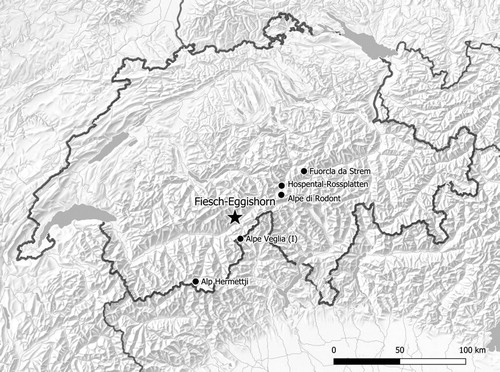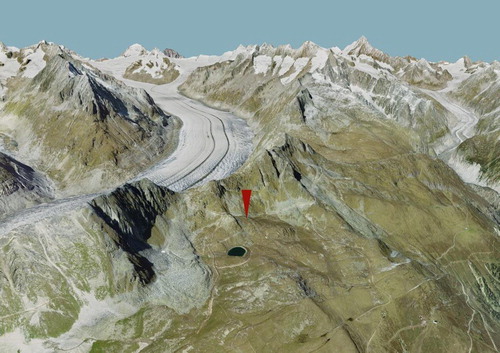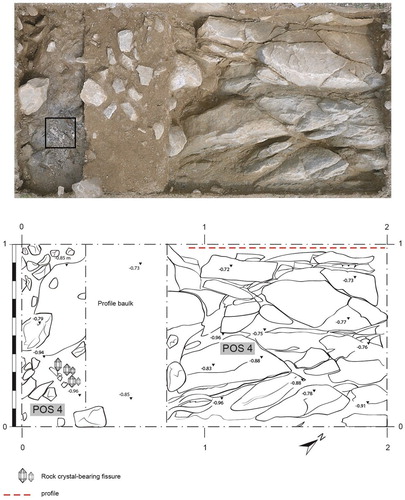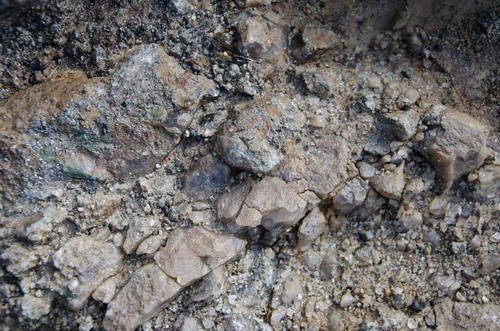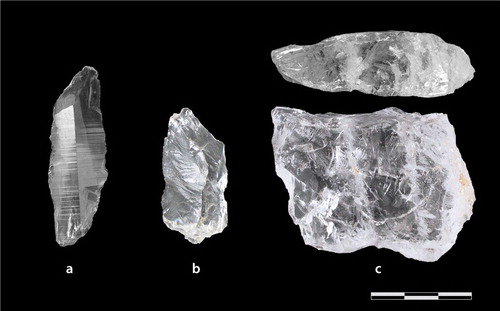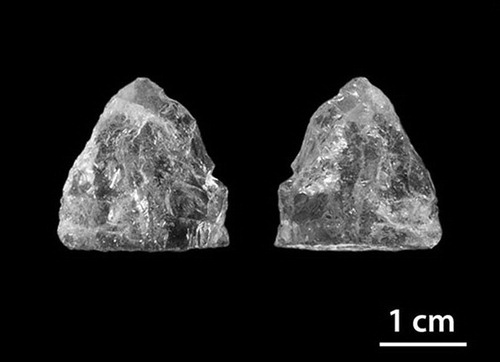ABSTRACT
Rock crystal is among the most fascinating materials in the archaeological record. It is formed in alpine-type fissures by hydrothermal processes. Due to its physical properties, rock crystal has been a valuable resource throughout human history. In alpine regions, it was frequently used for the production of stone tools between the Mesolithic and the Bronze Age. However, there are only a handful of known prehistoric crystal quartz quarries in Europe. The following article presents evidence for rock crystal mining during the Early Mesolithic and the final stage of the Neolithic at a high-altitude site in the Canton of Valais, Switzerland. In combination with radiocarbon dates from previous studies, the results of our fieldwork indicate that in the Swiss Alps rock crystal was mined almost 10,000 years ago. Furthermore, typo-technological analyses provide new insights into the way in which the raw material was processed during the represented time periods.
Introduction
Research history
Between 1990 and 1994, the amateur archaeologist Gertrud de Vries (1922–2011), whose family owns a holiday home in the Upper Valais, repeatedly discovered rock crystal objects near a construction site on Fiescheralp. As de Vries worked as a volunteer for the Canton of Basel, these objects were handed over to the Cantonal Archaeological Service after she had passed away. The latter contacted Thomas Hess in 2011 and asked him to reconstruct the archaeological context. With the permission of the responsible authorities, intensive field surveys in the Aletsch region were conducted during the following summer. As a result of these investigations, it was possible to relocate the site. Typo-technological analyses and an interregional comparison led to a better understanding of the finds and allowed a chronological classification. During the following years, additional surface finds were discovered. It was not until 2017 that the location – which is only accessible for a limited time during summer – was examined by the cantonal authorities and subsequently declared as a zone of archaeological interest. As the site was endangered by maintenance work within the skiing area, an international team under the auspices of the main author conducted an excavation in July 2019. The aim of the field campaign was to document the archaeological features and to study the human impact in the region.
Topography
The site is situated near Fiescheralp in Upper Valais on the southern edge of the Eggishorn Mountain at an elevation of 2575 m above sea level (). In this area, the slope drops gently and forms several small plateaus shaped by a glacier during the last ice age (). The vegetation can be described as alpine meadows, which are thinning out towards the hillside. Slightly below the site – which is now close to a hiking trail – there is an artificial lake. Due to the steep rock face running from northeast to southwest, the location is sheltered from wind. On the other side of the mountain range, the spectacular Aletsch Glacier flows down the valley. From the site, one has a breathtaking view over the Rhone Valley and several peaks of the Pennine Alps. On a clear day, it is even possible to recognize the famous Matterhorn in the distance. Additionally, the entrance to the Binn Valley, renowned for its rich mineral deposits, is visible. Further to the south, the Simplon Pass links Switzerland with Northern Italy. Only 16 km away from Fiescheralp, as the crow flies, is the Mesolithic site Alpe Veglia (I) (Gambari et al., Citation1989). The southern flanks of Eggishorn are strewn with boulders that were once transported by a rock glacier. In close proximity of the site, several rock shelters and quartz-bearing fissures were detected. The bedrock consists mainly of biotite gneiss. The entire area is well known among mineral collectors and during the construction of a cable car, a rock crystal group of several hundred kilos was discovered.
Materials and methods
Field work
Field surveys in the Aletsch region were conducted using topographic and geological maps. Of particular interest were large boulders that could have served as campsites as well as metamorphic rock formations including quartz veins. Each site was recorded using a standardized form and the coordinates were measured with a handheld GPS-device. The excavated surface at the rock crystal procurement site covered an area of 2 m2. Throughout the excavation, the sediment was removed in spits of 5 cm or until a new layer was reached. The entire backdirt was screened using a screen with a mesh size of 4 mm. Important points and single finds within the trench were spatially recorded using a differential GPS and an optical level. After each spit, the excavated area was documented photographically and as a drawing. The surface of the bedrock was cleaned of dust by using a pressure sprayer for final documentation. For a better understanding of the stratigraphic sequence, several smaller test pits (∼25 × 20 cm) were opened nearby and manual borehole drilling was conducted.
Lithic analysis
The lithic assemblage is composed of 460 surface finds collected between 1990 and 1994 as well as 125 objects discovered between 2012 and 2016. In the framework of the excavation in 2019, further 549 pieces were recovered, leading to a total amount of 1134 objects (≥1 cm). As all the finds belonged to the same site, they were analyzed as one assemblage. Typo-technological analyses were conducted using a Microsoft Access™ database. The classification system for the description of microliths is based on the work of Taute (Citation1971) and Heinen (Citation2012). Furthermore, the chronological sequence of sites in France and Northern Italy (Broglio & Kozłowski, Citation1983; Fontana et al., Citation2016; Kozłowski & Dalmeri, Citation2000; Valdeyron, Citation2008) served as an important point of reference. Metric analysis of the lithic artifacts was performed with Mitutoyo digital calipers. The weight of the lithic artifacts was determined using a precision scale with an accuracy of 0.1 g. Each artifact was studied under an optical microscope (Zeiss Stemi 2000) with a magnification of up to 80×.
Results
Archaeological features and finds
Due to construction work, the stratigraphic layers at the site were partly eroded and disturbed. The archaeological features consisted of an area of approximately 20 m2 in which lithic artifacts were visible on the surface. Near to the artifact concentration, a quartz vein indicated the presence of rock crystal. Borehole drilling in the surrounding area (about 20 m above the site) revealed alternating layers of clay and sand, representing several glacial advances and retreats. Within the 1 m × 2 m trench, the stratigraphic sequence (Figure ) was composed of fine-grained moraine sediment introduced by fluvioglacial processes, such as rainfall and meltwater. An intermixed layer of brown sandy silt, containing small- to medium-sized gravel (Pos. 1), was followed by a more coarse-grained sediment (including pieces of weathered biotite gneiss) with significantly fewer modern components (Pos. 2). The mentioned layers showed a high density of lithic artifacts. While Mesolithic artifacts occurred in both strata, Neolithic pieces were restricted to the uppermost layer. Underneath, the excavators encountered a stratum of dark grey to black material, rich in mica and iron oxide on top of the bedrock (Pos. 4). In the northwest-profile, there was a thin interstratified clay lens, containing Mesolithic finds that were still in situ (Pos. 3). The bedrock was reached at a depth of 3–23 cm below the surface. In the southwestern part of the trench, the archaeologists were able to document the original surface of the rock crystal-bearing fissure (Figures and). It included a quartz vein and small remaining crystals as well as chlorite sand. Because of strong weathering processes, the prisms are now only loosely attached to the surrounding bedrock.
Lithic technology
The lithic assemblage is composed of 1134 objects (≥1 cm) and 372 pieces of small debitage (<1 cm). It has a weight of 2572 g. 620 pieces show clear signs of intentional fracturing, such as bulbs of percussion and Wallner lines. Surprisingly, traces of a modern or a medieval exploitation of the material (e.g. marks produced by a metal hammer) were completely absent. In general, the rock crystal from Eggishorn is characterized by its extraordinary transparency. 50 pieces (4.4%) are overgrown with dark green chlorite. 24 objects (2.1%) contain tourmaline and 13 pieces (1.1%) are stained by limonite. Beside the normal habit, the rock crystal also displays the so-called Tessin habit with steep rhombohedral faces. Additionally, it includes double terminated pieces.
( and ) With 514 pieces (45.3%), shatter debitage forms the largest part of the assemblage. This is followed by preparation artifacts, such as crested blades and bladelets, core tablets and preparation flakes. With 262 pieces, these account for 23.1% of the find material. Flakes are represented by 147 pieces (13%), whereas laminar blanks are less prevalent; 9 blades (0.8%) and 33 bladelets (2.9%) were counted. Furthermore, 11 artifacts were categorized as non-determined blanks. The assemblage also contains 83 (7.3%) modified pieces and 39 (3.7%) modification products, such as burin spalls and microburins. Finally, 36 cores and core fragments were documented.
Figure 6. Lithic artifacts found at the site. (a) Burin-scraper. (b) Dihedral burin. (c) Perforator. (d), (e) Laterally retouched pieces. (f), (g) Blades. (h) Crested bladelet (figure by T. Hess).
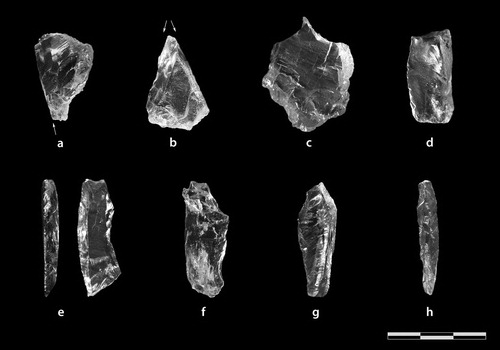
Table 1. Overview over the lithic assemblage (n = 1134).
The large number of preparation artifacts indicates that the raw material was processed directly at the site and further transported in the form of cores and blanks. Besides larger (most likely Neolithic) examples measuring up to 57.3 mm (Figure (c), small bladelet cores were recovered ((k)). More than half of them have a polyhedral shape, which is typical for the Early Mesolithic (Heinen, Citation2012, p. 542). Throughout the reduction sequence, they were continuously rotated along the main axes, leading to multidirectional negatives. The cores were sometimes placed on an anvil, which is evident by the occurrence of bulbs of percussion and eraillure flakes on the distal end of knapping products. One third of the cores show characteristics of a unidirectional reduction. Furthermore, there is a discoid example. In addition to entire prisms, shatters were transformed into small nuclei. The size of the cores and preparation flakes indicate that some of the crystals had a diameter of more than 6 cm. In other cases, prisms with maximum extensions of 4 cm were used.
Technological aspects, such as diffuse bulbs of percussion, external platform angles between 70° and 80°, and the so-called esquillement du bulbe suggest the application of direct percussion using a soft hammerstone (Andrefsky, Citation2005, pp. 13–20; Pelegrin, Citation2000) during the Mesolithic. The platform remains of laminar blanks are often triangular or trapezoidal. In most cases, the blanks display faceted platforms or traces of dorsal reduction.
Relatively steep external platform angles and a more extensive preparation of cores indicate that Neolithic blanks were produced using a soft organic hammer (Pelegrin, Citation2000).
With 27 artifacts (32.5%), microliths form the majority of modified pieces (). These are followed by burins which are represented by 14 pieces (16.9%). End-scrapers and laterally retouched artifacts are represented by 12 pieces (14.5%) each. The former include Mesolithic micro-scrapers as well as pieces with measurements of more than 3 cm. Most of the Mesolithic specimens show a longitudinal section typical of frequent re-sharpening (Andrefsky, Citation2005, p. 36) ((d)). With eight artifacts, multifunctional tools account for 9.6% of the assemblage. These are followed by perforators, which are represented by six pieces (7.2%) and truncations (two artifacts, 2.4%). Finally, a notched piece and a half-finished Neolithic arrowhead were discovered.
Table 2. Overview over the modified pieces in the assemblage (n = 83).
Similar to lithic assemblages from the Canton of Ticino, the natural crystal surfaces were sometimes integrated into artifacts (Hess et al., Citation2010; Kohler, Citation2018, p. 129) ((a); (l)). This implies a certain degree of specialization on the raw material that was mainly available on a seasonal basis. Interestingly, several modified pieces are inversely retouched ((j,l)). A number of 51 objects show traces of being altered by fire, which could be the result of an intentional heat-treatment of cores.
The microliths consist of 12 micro-points. Besides triangular and truncated pieces, so-called Sauveterre-points (Schäfer et al., Citation2016, p. 38) are also among the finds (). Furthermore, three backed bladelets, two scalene triangles and a crescent were discovered. Additionally, there are three semi-finished products of Mesolithic microliths. In case of seven fragments, it was not possible to reconstruct their original shape. Some microliths show characteristic impact-fractures (such as burinations or step fractures) implying that they were used as projectiles (Crombé et al., Citation2001; Pawlik, Citation2011; Pignat & Plisson, Citation2000, pp. 71–74), while others may have already been rejected during the manufacturing process.
Figure 8. Mesolithic artifacts, from left to right: Sauveterre-point, Microburin, Scalene triangle, Micro-point, Micro-scraper (figure by T. Hess).
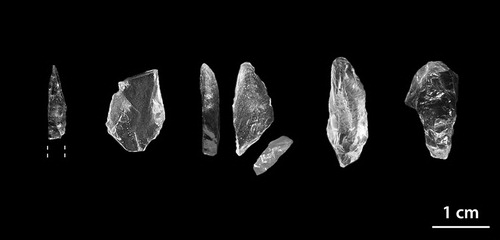
The aim of Mesolithic technology was to produce small bladelets that were transformed into microliths, using the microburin technique.
For the few Neolithic tools within the assemblage (), blades and larger flakes of a certain thickness – that were later bifacially retouched – served as blanks.
Contextualization
Microliths and microburins in combination with polyhedral cores typically indicate that the site was occupied in the Early Mesolithic. A comparison with other assemblages suggests a date between 8000 and 6500 BC, which corresponds to the Sauveterrian (). The spectrum of microliths displays great similarities to finds from the Simplon region (Crotti et al., Citation2004, pp. 272–274; Curdy et al., Citation2010) and the Mesolithic open-air site Alpe Veglia (I) (Gambari et al., Citation1989). The latter is situated on an alluvial fan at 1750 m above sea level (Guerreschi, Citation2002, p. 175). Whereas most other sites in the region seem to reflect relatively short occupations, Alpe Veglia has the character of a larger basecamp. Within the excavated area of approximately 165 m2, archaeological features including fireplaces, stone structures, and lithic workshops were discovered. Intermediate zones showing a complete absence of finds, are interpreted as sleeping spaces (Guerreschi, Citation2002, p. 176).
Table 3. Radiocarbon dates of reference sites containing lithic artifacts made of rock crystal.
Of further interest in this context is the Mesolithic rock shelter site Alp Hermettji (Curdy et al., Citation2003; Leuzinger, Citation2002). Situated on the foothills of the Matterhorn at an elevation of 2600 m above sea level, the location served as a hunting camp between the Early Mesolithic and the Middle Bronze Age. Large parts of the lithic artifacts (93%) are made of rock crystal that was presumably imported from the Upper Valais (Leuzinger, Citation2002, p. 172). According to radiocarbon dates, the Mesolithic features date between 8200 and 7200 BC.
On an interregional level, it is important to mention the Mesolithic and Bronze Age rock shelter site Alpe di Rodont on the summit of the St. Gotthard Pass. Within a small test pit of 60 cm × 80 cm, more than 600 g of lithic debitage and tools made of rock crystal were discovered. This could imply that the raw material was mined in close proximity to the site (Hess et al., Citation2010, pp. 187–189). The radiocarbon dates cover a time period between 7500 and 6500 BC for the Mesolithic occupation.
According to current knowledge, there exist only two other Mesolithic rock crystal mines in the Alps. One of them is the site Fuorcla da Strem (2815 m above sea level), located at the fringe of a glacier near a passage that links the Cantons of Uri and Grisons (Cornelissen, Citation2020; Reitmaier et al., Citation2016). At this site, a piece of red deer antler within a quartz-bearing fissure was discovered by a modern mineral searcher together with artifacts made of rock crystal. The object, which probably served as a tool for the extraction of the raw material, dates to the final stage of the Mesolithic (6th millennium BC) (Reitmaier et al., Citation2016, p. 136) ().
Another reference complex is the prehistoric rock crystal mine Riepenkar (A) in the Tyrolean Alps (Leitner, Citation2008; Leitner & Bachnetzer, Citation2011). At an elevation of 2800 m above sea level, an alpine-type fissure with a length of 12 m and a depth of up to 3 m was discovered. An evaluation of the finds indicates that the raw material was mined between the Mesolithic and the Neolithic (Leitner & Bachnetzer, Citation2011, p. 194). The composition of the assemblage from Riepenkar is similar to the one from Fiesch-Eggishorn. Among others, it includes laminar blanks, end-scrapers, burins, as well as triangular and trapezoidal microliths.
In addition to Mesolithic artifacts, there are diagnostic tools that imply a Neolithic use of the raw material outcrop at Fiesch-Eggishorn, such as bifacially retouched pieces, a large core with one striking platform, and a fragment of an arrowhead (, and ). Typologically, these date to a younger phase of the Neolithic (sometimes referred to as the Copper Age) (Honegger, Citation2001; Winiger & Besse, Citation2009). This was also the time of Ötzi the Iceman. The tools mentioned above were manufactured by pressure flaking (Andrefsky, Citation2005, pp. 12–14). Due to the homogeneity and the brittleness of the raw material, this technique is particularly suitable for rock crystal. Recent finds from the Iberian Peninsula (Morgado et al., Citation2016) as well as from the megalithic site Sion-Petit-Chasseur (VS) (Honegger, Citation2011, pp. 166–169) and the settlement at Bellinzona-Castel Grande (TI) (Donati, Citation1986) show the impressive skills of Neolithic toolmakers. In case of Sion-Petit-Chasseur, it is possible that the Upper Valais served as a source of raw material.
Figure 10. Drawings of lithic artifacts found at the site. (a)–(c) Microliths. (d) Micro-scraper. (e)–(h) Microburins. (i) Bifacially retouched piece. (j) Burin-scraper. (k) Mesolithic core. (l) Retouched blade. (m) Neolithic core (drawings by T. Hess).
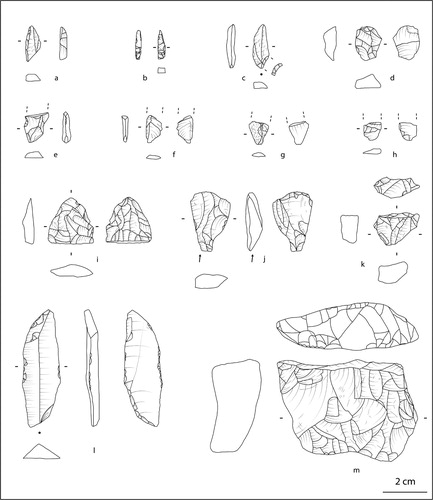
The closest reference site in case of the younger phase of occupation is the Copper and Bronze Age rock crystal workshop of Hospental-Rossplatten (UR) (Primas et al., Citation1992, pp. 307–323), which is approximately 40 km to the northeast of Fiescheralp as the crow flies (). On a plateau near a small lake, more than 10 kg of rock crystal debitage were discovered. It was possible to identify various stages of the reduction sequence. Similar to Fiesch-Eggishorn, cores were prepared at the site prior to be transported to settlements in the surrounding area.
Finally, there is evidence for extensive Neolithic rock crystal mining in the French Alps between the 6th and the 3rd millennium BC, involving the technique of fire-setting (Rostan, Citation2007; Rostan & Thirault, Citation2016). In the Oisans region, several quarries that are oriented along quartz veins occur within the same rock formation (Rostan & Thirault, Citation2016).
Discussion
As a result of the presented research, it is possible to show that the rock crystal mine at Fiescheralp was repeatedly visited by prehistoric groups during the Early Mesolithic (8000–6500 BC) and a younger phase of the Neolithic (3500–2200 BC). The large amount of lithic debitage implies extensive mining activities and a preparation of cores and blanks at the site. In addition, several hundred objects showing clear signs of lithic artifacts have been found at the locality, which makes it one of the oldest and most complete assemblages of its kind discovered so far. Due to the fact that the Valais is an extremely warm and dry area within the Alps (Nauser, Citation2016, p. 4), the site that is exposed to the southeast was already accessible during the Boreal. As a consequence of the dip of the rock formation, the quartz-bearing fissure runs nearly horizontal and was exposed to the surface. The prisms were probably extracted using stone mallets or antler tools similar to the ones that are known from other Mesolithic and Neolithic mining sites (Bachnetzer, Citation2017, pp. 34–35; Reitmaier et al., Citation2016, p. 139).
A common feature of the sites discussed here is their relatively remote location in high altitude zones above the timberline. This illustrates that Mesolithic hunter-gatherers invested considerable effort to acquire the precious raw material. The question of whether lithic resources were obtained by traveling to particular outcrops (direct procurement), or whether they were collected in the framework of other subsistence activities (embedded procurement), has been a matter of debate among archaeologists for a long time (Binford, Citation1979; Garvey, Citation2015; Gould & Saggers, Citation1985). Based on a comparison of topographic features (including accessibility and the proximity to glaciers or ice-patches), it can be assumed that there were specific expeditions to these places by some members of the community. This argues for a direct procurement.
Moreover, the new discoveries clearly demonstrate that rock crystal was far more than a substitute for flint and chert, as thought previously (cf. Primas et al., Citation1992). A reconstruction of the technological systems for both, the Mesolithic and the Neolithic argues for a specialized use of the material. This is not only evident from the integration of geometric crystal surfaces and the small size of blanks, but also from the fact that lithic assemblages in the Pennine Alps consist almost exclusively of rock crystal (Della Casa, Citation2005, p. 222; Guerreschi, Citation2002, p. 176). Finally, ethnographic analogies suggest that in addition to functional aspects, there might have been a symbolic meaning of rock crystal among prehistoric societies in Europe (Hess, Citation2020).
As mentioned above, the number of prehistoric sites in the Alps bearing evidence for the production of tools made of rock crystal has increased significantly over recent decades. Interestingly, most of them are connected by small valleys and mountain passes, which allowed prehistoric people to move between these regions. The Furka Pass, for instance, links the Upper Valais with the community of Hospental (UR), which is in turn connected to the site Alpe di Rodont (TI) via the St. Gotthard (Cornelissen & Reitmaier, Citation2016; Della Casa, Citation2018; Hess et al., Citation2010). In this context, it has been proposed that there was an intra-alpine exchange network dating as far back as the Mesolithic (Leitner & Bachnetzer, Citation2011, pp. 196–197). This hypothesis could be further investigated by analyzing fluid inclusions for lithic sourcing (Cousseran, Citation2000; Della Casa, Citation2000, p. 126; Mullis Citation1979).
The results presented in this article illustrate once again that prehistoric people had a profound knowledge of their environment. This knowledge did not only extend to meteorological processes, astronomical phenomena, and the behavior of animals but also included geological features as well as indicators for the presence of mineral resources.
Acknowledgements
We wish to thank the members of the Cantonal Archaeological Service of the Canton of Valais (namely Dr Caroline Brunetti, Corinne Juon, and Emmanuelle Evéquoz) for the permission to excavate, as well as Dr Philippe Curdy (formerly Musée d’Histoire du Valais), Dr Pierre-Yves Nicod (Musée d’Histoire du Valais), and Dr Thomas Reitmaier (Cantonal Archaeological Service of the Canton of Grisons) for their advice. The field campaign was funded by SGHB (Schweizerische Gesellschaft für Historische Bergbauforschung). The municipalities of Fiesch and Lax also contributed to the success of the project. Furthermore, we would like to express our gratitude to Dr Jürg Sedlmeier (Cantonal Archaeological Service of Canton Basel-Landschaft), K. de Vries and H. Plattner – who helped us to relocate the site – as well as Joëlle Jäger, Ronald Jaworski, and Nadine Moosmann for their participation in fieldwork. Finally, we would like to thank Judith Bucher (University of Zurich) for creating the figures and Sarah Jennings (University of Aarhus) for proofreading the article.
Disclosure statement
No potential conflict of interest was reported by the author(s).
Data availability statement
The data that support the findings of this study are available from the corresponding author, [T. H.], upon reasonable request.
Additional information
Funding
Notes on contributors
Thomas Hess
Thomas Hess has studied Prehistoric Archaeology and Earth Sciences at the Universities of Zurich and Cambridge. In 2016 he completed his PhD at the University of Tübingen on the lithic artifacts from a Late Magdalenian and Early Mesolithic rock shelter site on the Swabian Jura. Currently, he is conducting research on the occurrence of lithic raw materials in Central Germany funded by the Swiss National Science Foundation (SNSF). His research interests include lithic analysis (especially lithic sourcing), Paleolithic and Mesolithic cultures, Alpine archaeology, archaeological theory, diachronic landscape studies, and ethnoarchaeology. Thomas Hess relocated the site, conceptualized the study, directed the fieldwork, conducted the lithic analysis, and wrote the paper.
Rouven Turck
Rouven Turck has been working at the University of Zurich since 2012. His research focuses on archaeometry, Alpine archaeology, and metallurgy. He is directing research projects dealing with mining in prehistory (especially copper ores) in Grisons and Valais (Switzerland). Rouven Turck was involved in planning the excavation and took measurements in the field.
Gertrud de Vries
Gertrud de Vries (1922–2011) has worked as a volunteer for the Cantonal Archaeological Service of the Canton of Basel-Land. She was cooperating closely with Dr Jürg Sedlmeier and has discovered several archaeological sites in Switzerland. Gertrud de Vries discovered the first lithic surface finds at the site in the 1990s.
Philippe Della Casa
Philippe Della Casa is a professor for Prehistoric Archaeology at the University of Zurich. His main research interests are with mountain environments, in particular with the Alps, and the challenges they posed for pre- and protohistoric people in terms of ecology, settlement, resources, communication, and societal structuring. Philippe Della Casa provided scientific advice and the general infrastructure for the fieldwork.
References
- Andrefsky, W. (2005). Lithics: Macroscopic approaches to analysis. Cambridge University Press. https://doi.org/10.1017/CBO9780511810244
- Bachnetzer, T. (2017). Prähistorischer Feuersteinbergbau im Kleinwalsertal, Vorarlberg. Silex und Bergkristallabbaustellen in Österreich (Praearchos 5). Verlag A. Weger.
- Binford, L. R. (1979). Organization and formation processes: Looking at curated technologies. Journal of Anthropological Research, 35(3), 255–273. https://doi.org/10.1086/jar.35.3.3629902
- Broglio, A., & Kozłowski, S. K. (1983). Tipologia ed evoluzione delle industrie mesolitiche di Romagnano III. Preistoria Alpina, 19, 93–148.
- Cornelissen, M. (2020). Strahlen. Bergkristall in der Steinzeit: Archäologische Zeugnisse aus dem Gebiet zwischen Gotthard, Ursern und Oberalppass. Kanton Uri.
- Cornelissen, M., & Reitmaier, T. (2016). Filling the gap: Recent Mesolithic discoveries in the central and south-eastern Swiss Alps. Quaternary International, 423, 9–22. https://doi.org/10.1016/j.quaint.2015.10.121
- Cousseran, S. (2000). L’étude des inclusions fluides appliquée au problème de la circulation des quartz archéologiques dans les Alpes occidentales: Acquisition de nouvelles données sur les gîtes primaires. Revue d’Archéométrie, 24(1), 169–177. https://doi.org/10.3406/arsci.2000.996
- Crombé, P., Perdaen, Y., Sergant, J., & Caspar, J.-P. (2001). Wear analysis on Early Mesolithic microliths from the Verrebroek Site, East Flanders, Belgium. Journal of Field Archaeology, 28(3–4), 253–269. https://doi.org/10.1179/jfa.2001.28.3-4.253
- Crotti, P., Curdy, P., & Leuzinger, U. (2004). La région du Simplon (Valais), du Mésolithique à l’époque moderne: campagne de prospection 2003. Jahrbuch der Schweizerischen Gesellschaft für Ur- und Frühgeschichte, 87(87), 271–278. http://doi.org/10.5169/seals-117793
- Curdy, P., Bullinger, J., Crotti, P., Valsecchi, V., & Tinner, W. (2010). Archaeological survey around the Simplon and Albrun passes (Valais, Piemont), from Mesolihic to Roman period. In S. Tzortzis & X. Delestre (Eds.), Archéologie de la Montagne Européenne (Bibliothèque d’Archéologie Méditerranéenne et Africaine 4, pp. 185–195). Errance.
- Curdy, P., Leuzinger-Piccand, C., & Leuzinger, U. (2003). Zermatt Alp Hermettji et les cols secondaires du Valais. In M. Besse, L.-I. Stahl Gretsch, & P. Curdy (Eds.), Constellasion. Hommage à Alain Gallay (Cahiers d’archéologie romande 95, pp. 73–88). CAR.
- Della Casa, P. (2000). Mesolcina praehistorica: Mensch und Naturraum in einem Bündner Südalpental vom Mesolithikum bis in römische Zeit (Universitätsforschungen zur prähistorischen Archäologie 67). Habelt.
- Della Casa, P. (2005). Lithic resources in the early prehistory of the Alps. Archaeometry, 47(2), 221–234. https://doi.org/10.1111/j.1475-4754.2005.00198.x
- Della Casa, P. (Ed.). (2018). The Leventina Prehistoric Landscape (Zurich Studies in Archaeology 12). Chronos Verlag.
- Donati, P. (1986). Bellinzona a Castel Grande: 6000 anni di storia. AS, 9(3), 94–109. http://doi.org/10.5169/seals-8233
- Fontana, F., Flor, E., & Duches, R. (2016). Technological continuity and discontinuity in the Romagnano Loc III rock shelter (NE Italy) Mesolithic series. Quaternary International, 423, 252–265. https://doi.org/10.1016/j.quaint.2015.10.046
- Gambari, F., Ghiretti, A., & Guerreschi, A. (1989). Il sito mesolitico di Cianciàvero nel Parco Naturale di Alpe Veglia (Alpi Lepontine, Val d’Ossola, Novara). Preistoria Alpina, 25(25), 47–52.
- Garvey, R. (2015). A model of lithic raw material procurement. In N. Goodale & W. Andrefsky (Eds.), Lithic technological systems and evolutionary theory (pp. 156–171). Cambridge University Press.
- Gould, R. A., & Saggers, S. (1985). Lithic procurement in Central Australia: A closer Look at Binford’s idea of embeddedness in archaeology. American Antiquity, 50(1), 117–136. https://doi.org/10.2307/280637
- Guerreschi, A. (2002). Alpe Veglia: prähistorische Jäger im Simplon-Gebiet. In P. Curdy (Ed.), Die ersten Menschen im Alpenraum von 50 000 bis 5000 vor Christus (pp. 174–177). Neue Zürcher Zeitung/Walliser Kantonsmuseen.
- Heinen, M. (2012). Grundformproduktion und -verwendung im frühen Mesolithikum Mitteleuropas. In H. Floss (Ed.), Steinartefakte: vom Altpaläolithikum bis in die Neuzeit (pp. 535–548). Kerns.
- Hess, T. (2020). Looking through the crystal ball: Ethnographic analogies for the symbolic use of rock crystal. In G. Cooney, B. Gilhooly, N. Kelly, & S. Mallía-Guest (Eds.), Cultures of stone. An interdisciplinary approach to the materiality of stone. Dublin, 18th–20th September 2014 (pp. 289–302). Leiden.
- Hess, T., Reitmaier, T., Jochum Zimmermann, E., Ballmer, A., Dobler, I., & Della Casa, P. (2010). Leventina: Prähistorische Siedlungslandschaft. Archäologischer Survey im alpinen Tessintal und entlang der Gotthardpassroute in 2007–08. Jahrbuch Archäologie Schweiz, 93(93), 173–192. https://doi.org/10.5167/uzh-35066
- Honegger, M. (2001). L’industrie lithique taillée du néolithique moyen et final de Suisse (Monographie du Centre de Recherches Archéologique 24). Éditions du CNRS.
- Honegger, M. (2011). L’industrie en silex et en quartz taillés de l’habitat du Petit-Chasseur à Sion (Valais). In M. Besse & M. Piquet (Eds.), Le site préhistorique du Petit-Chasseur (Sion, Valais) 10. Un hameau du Néolithique moyen (Cahiers d’archéologie romande 124, pp. 165–181). CAR.
- Kohler, P. (2018). Results of the 2015 UBC rescue excavation in Airolo-Madrano. In P. Della Casa (Ed.), The Leventina prehistoric landscape (Zurich Studies in Archaeology 12, pp. 121–131). Chronos.
- Kozłowski, S. K., & Dalmeri, G. (2000). Riparo Gaban: The Mesolithic layers. Preistoria Alpina, 36, 3–42.
- Leitner, W. (2008). The oldest silex and rock crystal mining traces in high alpine regions. In S. Grimaldi, T. Perrin, & J. Guilaine (Eds.), Mountain environments in prehistoric Europe: Settlement and mobility strategies from the Palaeolithic to the Early Bronze Age (BAR – International Series 26, pp. 115–120). Archaeopress.
- Leitner, W., & Bachnetzer, T. (2011). Steinzeitliche Gewinnung von Bergkristall in den Tuxer Alpen. In K. Oeggl, G. Goldenberg, T. Stöllner, & M. Prast (Eds.), Die Geschichte des Bergbaus in Tirol und in seinen angrenzenden Gebieten (Proceedings zum 5. Milestone-Meeting des SFB-HiMAT vom 7.–10.10.2010 in Mühlbach) (pp. 193–198). Innsbruck.
- Leuzinger, U. (2002). Zermatt-Alp Hermettji: Jagdlager am Fusse des Matterhorns. In P. Curdy (Ed.), Die ersten Menschen im Alpenraum von 50 000 bis 5000 vor Christus (pp. 171–173). Neue Zürcher Zeitung/Walliser Kantonsmuseen.
- Morgado, A., Lozano, J. A., Garcia Sanjuán, L., Luciañez Triviño, M., Odriozola, C. P., Lamarca Irisarri, D., & Fernandez Flores, A. (2016). The allure of rock crystal in Copper Age southern Iberia: Technical skill and distinguished objects from Valencina de la Concepción (Seville, Spain). Quaternary International, 424, 232–249. https://doi.org/10.1016/j.quaint.2015.08.004
- Mullis, J. (1979). The system methane-water as a geological thermometer and barometer from the external part of the Central Alps. Bulletin de Minéralogie, 102(5), 526–536. https://doi.org/10.3406/bulmi.1979.7301
- Nauser, M. (2016). Das Wallis angesichts des Klimawandels: Auswirkungen und Anpassungsmöglichkeiten in den Bereichen Wasserbewirtschaftung und Naturgefahren. Staat Wallis, Dienststelle für Wald und Landwirtschaft.
- Pawlik, A. F. (2011). Die funktionale Analye der Steingeräte und die Rekonstruktion der Aktivitäten am Ullafelsen. In D. Schäfer (Ed.), Das Mesolithikum-Projekt Ullafelsen (Teil 1) (pp. 355–459). Philipp von Zabern.
- Pelegrin, J. (2000). Les techniques de débitage laminaire au Tardiglaciaire: critères de diagnose et quelques réflexions. In B. Valentin, P. Bodu, & M. Christensen (Eds.), L’europe centrale et septentrional au Tardiglaciaire. Actes de la table-ronde de Nemours, mai 1997 (Mémoires du Musée de Préhistoire d’Île-de-France 7, pp. 73–86). Editions A.P.R.A.I.F.
- Pignat, G., & Plisson, H. (2000). Le quartz, pour quel usage? L’outillage mésolithique de Vionnaz (CH) et l’apport de la tracéologie. In P. Crotti (Ed.), MESO ′97. Actes de la Table ronde «Epipaléolithique et Mésolithique» (Cahiers d’archéologie romande 81, pp. 65–78). CAR.
- Primas, M., Della Casa, P., & Schmid-Sikimić, B. (1992). Archäologie zwischen Vierwaldstättersee und Gotthard (Universitätsforschungen zur prähistorischen Archäologie 12). Habelt.
- Reitmaier, T., Auf der Mauer, C., Reitmaier-Naef, L., & Walser, C. (2016). Spätmesolithischer Bergkristallabbau auf 2800 m Höhe nahe der Fuorcla da Strem Sut (Kanton Uri / Graubünden / CH). Archäologisches Korrespondenzblatt, 46(2), 133–148.
- Rostan, P. (2007). First data on the exploitation of hyaline quartz crystals in the upper Romanche (Isère and Hautes Alpes, France). Preistoria Alpina, 42(42), 75–82.
- Rostan, P., & Thirault, E. (2016). L’usage du quartz hyalin dans les Alpes durant la Préhistoire: une vue d’ensemble. Nouvelles données en Oisans (Isère et Hautes-Alpes. In A. Tomasso, D. Binder, G. Martino, G. Porraz, P. Simon, & N. Naudinot (Eds.), Ressources lithiques, productions et transferts entre Alpes et Méditerranée. Actes de la séance de la société préhistorique française, Nice 28–29 Mars 2013 (Séances de la société préhistorique française 5, pp. 97–136). SPF.
- Schäfer, D., Bertola, S., Pawlik, A., Geitner, C., Waroszewski, J., & Bussemer, S. (2016). The landscape-archaeological Ullafelsen Project (Tyrol, Austria). Preistoria Alpina, 48, 33–41.
- Taute, W. (1971). Untersuchungen zum Mesolithikum und zum Spätpaläolithikum im südlichen Mitteleuropa. Band 1: Chronologie Süddeutschlands. Unpublished habilitation treatise. University of Tübingen.
- Valdeyron, N. (2008). Sauveterrien et Sauveterriano: Unité ou diversité du premier Mésolithique en France méridionale et en Italie du Nord. PALLAS, 76(76), 247–259.
- Winiger, A., & Besse, M. (2009). Le mobilier du Néolithique moyen de Saint-Léonard Sur-le-Grand-Pré (Valais, Suisse). Fouilles Sauter 1956–1962 (Cahiers d’archéologie romande 113). CAR.

